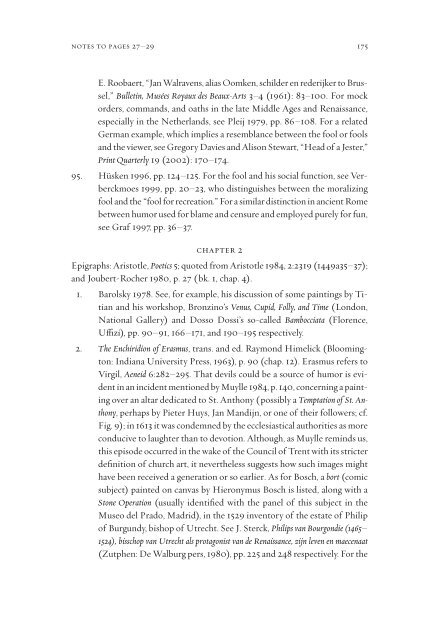Pieter Bruegel and the Art of Laughter - AAAARG.ORG
Pieter Bruegel and the Art of Laughter - AAAARG.ORG
Pieter Bruegel and the Art of Laughter - AAAARG.ORG
Create successful ePaper yourself
Turn your PDF publications into a flip-book with our unique Google optimized e-Paper software.
notes to pages 27–29 175<br />
E. Roobaert, “Jan Walravens, alias Oomken, schilder en rederijker to Brussel,”<br />
Bulletin, Musées Royaux des Beaux-<strong>Art</strong>s 3–4 (1961): 83–100. For mock<br />
orders, comm<strong>and</strong>s, <strong>and</strong> oaths in <strong>the</strong> late Middle Ages <strong>and</strong> Renaissance,<br />
especially in <strong>the</strong> Ne<strong>the</strong>rl<strong>and</strong>s, see Pleij 1979, pp. 86–108. For a related<br />
German example, which implies a resemblance between <strong>the</strong> fool or fools<br />
<strong>and</strong> <strong>the</strong> viewer, see Gregory Davies <strong>and</strong> Alison Stewart, “Head <strong>of</strong> a Jester,”<br />
Print Quarterly 19 (2002): 170–174.<br />
95. Hüsken 1996, pp. 124–125. For <strong>the</strong> fool <strong>and</strong> his social function, see Verberckmoes<br />
1999, pp. 20–23, who distinguishes between <strong>the</strong> moralizing<br />
fool <strong>and</strong> <strong>the</strong> “fool for recreation.” For a similar distinction in ancient Rome<br />
between humor used for blame <strong>and</strong> censure <strong>and</strong> employed purely for fun,<br />
see Graf 1997, pp. 36–37.<br />
chapter 2<br />
Epigraphs: Aristotle, Poetics 5; quoted from Aristotle 1984, 2:2319 (1449a35–37);<br />
<strong>and</strong> Joubert-Rocher 1980, p. 27 ( bk. 1, chap. 4).<br />
1. Barolsky 1978. See, for example, his discussion <strong>of</strong> some paintings by Titian<br />
<strong>and</strong> his workshop, Bronzino’s Venus, Cupid, Folly, <strong>and</strong> Time (London,<br />
National Gallery) <strong>and</strong> Dosso Dossi’s so-called Bambocciata (Florence,<br />
U‹zi), pp. 90–91, 166–171, <strong>and</strong> 190–195 respectively.<br />
2. The Enchiridion <strong>of</strong> Erasmus, trans. <strong>and</strong> ed. Raymond Himelick (Bloomington:<br />
Indiana University Press, 1963), p. 90 (chap. 12). Erasmus refers to<br />
Virgil, Aeneid 6:282–295. That devils could be a source <strong>of</strong> humor is evident<br />
in an incident mentioned by Muylle 1984, p. 140, concerning a painting<br />
over an altar dedicated to St. Anthony ( possibly a Temptation <strong>of</strong> St. Anthony,<br />
perhaps by <strong>Pieter</strong> Huys, Jan M<strong>and</strong>ijn, or one <strong>of</strong> <strong>the</strong>ir followers; cf.<br />
Fig. 9); in 1613 it was condemned by <strong>the</strong> ecclesiastical authorities as more<br />
conducive to laughter than to devotion. Although, as Muylle reminds us,<br />
this episode occurred in <strong>the</strong> wake <strong>of</strong> <strong>the</strong> Council <strong>of</strong> Trent with its stricter<br />
definition <strong>of</strong> church art, it never<strong>the</strong>less suggests how such images might<br />
have been received a generation or so earlier. As for Bosch, a bort (comic<br />
subject) painted on canvas by Hieronymus Bosch is listed, along with a<br />
Stone Operation (usually identified with <strong>the</strong> panel <strong>of</strong> this subject in <strong>the</strong><br />
Museo del Prado, Madrid), in <strong>the</strong> 1529 inventory <strong>of</strong> <strong>the</strong> estate <strong>of</strong> Philip<br />
<strong>of</strong> Burgundy, bishop <strong>of</strong> Utrecht. See J. Sterck, Philips van Bourgondie (1465–<br />
1524), bisschop van Utrecht als protagonist van de Renaissance, zijn leven en maecenaat<br />
(Zutphen: De Walburg pers, 1980), pp. 225 <strong>and</strong> 248 respectively. For <strong>the</strong>












